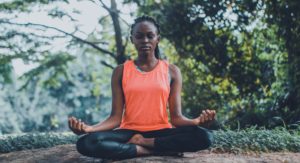The world is getting crazier and people are more and more stressed out. Between the political climate and the actual climate, we’re feeling the heat and it’s taking its toll.
It’s impossible to know how things will go – will our government do the right thing? Will business and industry finally wake up to the crisis of global warming? – but there’s something we can all do, right now, to cope a lot better. It’s called mindfulness meditation.
Mindfulness meditation comes out of the old tradition of religious meditation. It’s been done for ages by the Buddhist priests, Hindu worshipers, Tibetan Lamas, Jewish and Christian mystics. Interestingly, there are a number of things all these traditions have in common.
In order to meditate, or to practice mindfulness meditation, a person needs to sit quietly in a room with no distractions and they need to focus – whether on their breath, a few repeated words or on an object. The purpose is to clear the mind of all the chatter and find a calm, peaceful state of being for a few minutes during each day.
Mindfulness meditation separates this practice from its original religious basis and allows everyone and anyone to enjoy it. You can follow whatever religion, or no religion, you choose, and you can also enjoy the practice of mindfulness meditation.
The most challenging part of any mindfulness practice isn’t the actual sitting and breathing. It’s not even the efforts you make to silence the chatter in your mind. The biggest challenge of mindfulness is finding the discipline to make the time each day to sit and focus. For some reason, we’ll do almost anything rather than stop, breathe and try to calm our racing thoughts.
It’s as though our minds are attached to the business and the speed and they resist our desires to slow down. It’s up to each of us to be determined to carve out the five, ten or twenty minutes, once or twice each day to sit, breathe and focus our attention.
The good news is that the more we practice mindfulness meditation, the more benefits will accrue and the more motivated we’ll be to do it on a regular basis. When we start feeling calmer, happier and more energized we’ll be glad to make the time each day to do our mindfulness practice.
The other thing that might make it challenging to do a regular mindfulness practice is that it isn’t easy to calm the mind. As soon as we’ve taken a breath we’re thinking about something and off we go into a whole new stream of thoughts. We finally catch ourselves doing this and have to stop, refocus, and go back to our breathing, counting or whatever it is that we’re putting our attention on.
it’s important not to get angry or disappointed with ourselves. We can notice that our mind has wandered and just bring ourselves back to focus. With a bit of self-compassion, we can lose our focus and then regain it over and over again without ever feeling bad.
We don’t have to get fixated on the goal of an empty mind. That will happen if and when it happens. In the meantime, we just keep coming back to the breath, the candle, the counting. The goal is to keep meditating, more than to empty the mind ASAP.
One mindfulness exercise I really enjoy doing is the body scan. It’s a way for me to tune in and notice where I’m holding tension or pain in my body. It’s a very simple exercise to do.
You sit in a chair with a straight back and plant your feet on the floor. You bring your attention to your breathing and notice your in-breaths and out-breaths. Then, starting with the soles of your feet, as you continue to inhale and exhale through your nostrils, notice how each part of your body feels.
Travel up your body, not missing any part, inside or out. Notice if there’s any pain, tension, tightness or restriction, and then breath some positive energy into each of these parts of your body.
You don’t need to try and change anything in this exercise. You can just notice, and breathe, and keep your feet grounded on the floor. Notice these parts of your body without judgment or trying to analyze anything. You can do these things later.
While you’re doing the mindfulness exercise, all you need to do is notice, breathe, and move on to the next body part. And then, at the end, just take a moment to tune in to how you feel, mentally, physically and emotionally. Usually, it feels good to be in touch with the body, even if we notice some aches and pains or tightness.
Doing this exercise can have a calming and integrating effect. You may discover some tightness in your shoulder that had been bothering you just under the surface of your conscious awareness, and now you can attend to this tightness more directly.
This is just one of many mindfulness exercises. There are CDs and apps which can guide you through many more. Find a few that you enjoy doing and try to do them regularly. You have no idea how much better you’ll feel and how much easier it will be to cope with all the stresses of our increasingly crazy world.
Sign up here for my free biweekly wellness newsletter that brings you fresh, thought-provoking content.
Subscribe to my YouTube Channel to watch my series Moving into Autumn with Good Self-Care, where you’ll learn simple tips for taking the best care of yourself and your loved ones this fall season.
Tune in to my Ruthless Compassion Podcast where I go in-depth about topics like mental health, trauma, and loneliness.


